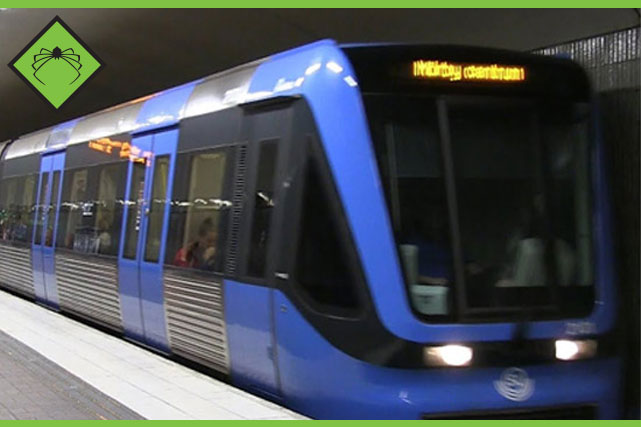 The Challenge
The Challenge
In underground locations heavily used by the public, robust wireless communication
networks are crucial for the provision of continuous communications during emergencies.
The technology of choice for public safety authorities is TETRA, due to its resilience and
reliability during disaster scenarios. However, with new standards and regulations
changing the public safety network landscape, TETRA has to continuously evolve to keep
pace.
The Swedish operator SL is responsible for overseeing Stockholm’s metro network.
Construction of the network started in 1950 and the latest station opened in 1994. Today,
the metro network consists of 100 underground stations, 50 stations above ground, and a
total of 105km of track. The metro’s public safety network has to support over 1,000,000
journeys on a daily basis. The wireless network’s duty of care extends further than the
Metro’s customers though, with over 3,000 staff needing constant and consistent
communications with the operational hub.
To provide a comprehensive coverage solution, SL chose a TETRA network, which for 17
years was supported by a sub-com system, providing coverage in underground sections
over three different radio services: train communications linking the operation managers
to their drivers and workers in the network, coverage for the Swedish Police and for
Stockholm’s Fire and Rescue services.
However, over the years the sub-com system began to be impacted by the strain of
supporting the Metro network. It was struggling to supply air links to base stations above
ground, because of new buildings causing interference issues for 160MHz band signals.
The cables linking the system were over 15 years old, there were a limited number of
optical fibres available and advances in cellular technology meant that the combination of
public safety, broadcast and cellular coverage was required in the upgrade.
SL had to provide ubiquitous coverage not only for the emergency services, but also for
public use across the GSM spectrum at different frequencies. Overseeing such a huge
project was tough, but even more complicated for SL was to upgrade the network while
keeping the old analogue system fully functioning; in order to keep the network up and
running.
The Key Issues
- Totally redundant - The network had to support rail communications, through a
completely redundant public safety system, and provide a public network for national
mobile network operators.
- Replacing old connectors - Cables in tunnels are subjected to a huge amount of
vibration, and chocks and connectors are weak points that are often susceptible to
degradation. Existing connectors were over 15 years old and needed replacing.
- Transitioning old to new - During the switch over there had to be a smooth transition
from the old system to the new. The old system had to run in parallel with the new one
in order to keep supplying comprehensive coverage to the Metro operator.
Provision for the future – The network had to be prepared to support SL’s own
forthcoming TETRA system and be capable of adapting to future requirements and
expansions.
 The Solution
The Solution
In 2008, to cope with these various challenges, SL commissioned PBE Axell to
install a highly robust network to replace its existing 17 year-old one. PBE Axell
supplied a new multi-band system consisting of over 70 repeaters providing radio
coverage alongside the 105km long metro track. In addition, a number of repeaters were
installed to provide coverage for the commuter trains and the tram lines. The multi-band
system supports the existing radio systems while also providing coverage for a TETRA
public safety network for the emergency services, a TETRA train communication and
information network, and various commercial mobile radio services. With any TETRA
deployment the first task is to ensure public safety. To meet the high reliability and
availability requirements of the new Stockholm Metro system, and ensure a smooth
transition, PBE Axell employed a ‘distributed antenna system’ based on ‘fibre-fed
repeaters’. Using this method, a single base station can be positioned at each end of a
section of tunnel, or group of tunnels, to feed repeaters placed at each underground
station, connected through optical fibres.
Fibre optic repeater systems in TETRA networks overcome the challenges of underground
locations by leveraging usability and flexibility. The use of these repeaters allows base
station coverage to be boosted and extended over great distances to remote locations;
removing the issues associated with continuous communications underground. A reliable
TETRA radio system must continue performing despite any failures to the system itself.
This problem is solved by two independent base stations providing overlapping coverage
underground. Each base station is configured to feed several repeaters placed inside a
tunnel, and overlapping coverage exists between two adjacent repeaters. If a repeater
fails, the other repeater sited next to it will carry on providing coverage. The requirement
for critical resilience, ensuring that there are no coverage black spots for the emergency
services, is of vital importance. The system installation was strong, yet flexible, allowing
the secure handover of RF communications from one unit to the next, should a base
station or repeater suddenly be damaged or destroyed during a crisis. This ensures the
emergency services receive continuous coverage in an enclosed, and potentially
hazardous, environment.
Management and control of the network
To enhance SL’s visibility across their entire network, PBE Axell installed its
software manager Active Element Manager (AEM), to create a balanced system with one
technological interface. This provided SL with a supervision system that is able to
remotely shut down, or upgrade the network when needed.
Software-defined radio changes the landscape
A smooth transition from an analogue system to a resilient dual-purpose network
supporting both public safety and commercial use would not have been possible without
the emergence of repeaters using software defined radio (SDR), such as PBE Axell’ channel selective CSR438 repeater. SDR is a collection of hardware and
software technologies that enable reconfigurable system architectures for wireless
communications. Traditional hardware-based radio devices limit cross-functionality and
can only be modified through physical intervention. SDR enables new wireless features
and capabilities to be added to existing radio systems through software upgrades, rather
than a hardware upgrade, thus providing a TETRA operator with the flexibility to specify
and change sub-band allocations, simplifying the process of updating to new standards in
network functionality.
 The Benefit
The Benefit
Smoothing the transition - In order to keep the old analogue system operational
during the transition the signals from the sub com rack were connected to the new racks.
During the upgrade the following radio systems were supported: Police, Fire and Rescue,
Train radio communication, BussKom (SL’s TETRA System), RAKEL (Swedish nationwide
TETRA system), FM-Radio, GSM 900 and GSM 1800.
Efficient network - The upgraded network now only uses 4 downlink sites for train
radio compared to 70 previously as most of the downlink sites have been replaced with
TETRA base stations. Antennas in ticket halls were replaced by leaky feeders to further
streamline the network. The network for commuter trains and tram lines uses 10
downlink sites equipped with PBE Axell digital CSR438 repeaters and no
underground base stations.
Fully redundant network - As a fully redundant system if any part fails the system will
continue to run through overlapping coverage between stations. Two independent base
stations provide additional capacity and redundancy with a further dedicated site. Two
independent fibre paths feed each repeater with redundant station coverage provided by
the adjacent stations in case of a repeater failure. This comprehensive wireless system
meets stringent safety standards, as the network is underpinned by an automatic single
level control, which is integrated in the system, so in the event of any failures the signal
will still be carried.
Easy to extend - Providing radio frequency over fibre makes the network flexible to
upgrade and offers the ability to add to the network when expansion is needed.
Future-proof solution - The installation also saw the introduction of SDR-based
equipment to support FM radio frequencies. A built in SDR coverage solution can be
remotely configured using software updates. This provides a TETRA operator with the
flexibility to specify and change sub-band allocation providing an easier path to new
standards.


